Just wondering if anyone is interested in Opuntia polyacantha and all it's many derivations and forms.
Comments
Re: Anyone have an interest in O. polyacatha?
The reason I ask this question is that a lot of rock gardening people don't like to deal with the glochids.
And I didn't want to bore the members since O. polyacantha has so many varieties and the distinctions between them, are very confusing.
Of all the cylindropuntias, C. imbricata is the hardiest, but in your climate it would be very marginal. I wish you luck in finding a clone that will grow in your area. The good thing is, it only takes a small branch cutting to get a start going.
Re: Anyone have an interest in O. polyacatha?
I never met an opuntia I didn't like, but I transplanted all (or almost all) of my polyacanthas to the front yard next door, because they take up so much room and there was plenty of room next door (and my neighbor likes cactus). And because I have the habit of putting my hands on them when I'm weeding in my front yard.
There aren't any forms of O. polyacantha that I know of that are as wicked as O. rufida, which fortunately proved not to be hardy in the place where I put it, though I recently got a dwarf form of O. basilaris that's nothing but glochids. It's staying in a pot outdoors this winter.
Now, cylindropuntias, different story. There is a forest of them in the front yard. And a large collection in the back. I still manage to walk backwards into one every so often.
Bob
Re: Anyone have an interest in O. polyacatha?
Bob
It's good to hear that you like Opuntias. They do indeed like a bit of space if allowed to do their thing unchecked. I trim all my patches to keep them within bounds and out of the paths. That usually means I have plenty of pads to share.
O. polyacantha has a very wide distribution across central and western North America with several varieties recognized. There are a lot of unrecognized local forms with names that are not considered valid or in dispute at this time.
In general O. polyacantha is a highly adaptable species across it's range and hybridizes readily with several other Opuntia species. Due to it's genetic flexability, there is a wide range of physical characteristics within the complex. The differant forms grow as low spreading mounds. Flower colors are normally in a range of intensities, in the colors pink or yellow. Spine counts, color, thickness, length and density vary widely across it's range. The fruits are always dry when ripe.
I started growing O. polyacantha about thirty years ago with plants collected from The northern Great Plains.
The variety found there is Opuntia polyacantha var. polyacantha. This is one of the hardiest cacti found in North America and can handle frigid winter temperatures.
As you will see from the photos there is a range of yellow to cream colors displayed by the clones I grow. The red stamen filaments setting off the green stigma and medium length spines seem to be consistant in this Great Plains native.
This clone was collected in the Badlands of South Dakota.
This one from Emmons county North Dakota.
This one is a selection that has been given the name 'Crystal Tide'
And here is an over view of the general appearance of this variety.
Re: Anyone have an interest in O. polyacatha?
A Prickly Pear was the very first plant I started growing as a boy. I got a pad from someone (have forgotten who) and it eventually grew to 2m in a pot at home. I still have a piece of it but a more mangable size.
I dream of trying some in the garden but I think it is too wet here in winter :-\ Your plants are beautiful, John ;)
When I visited Galapagos I remember well the tall Opuntia trees there. A very special forest. Sorry, no pictures as all are on slides but it looked like this:
http://www.mountainsoftravelphotos.com/Galapagos%20Islands/Day%202/slide...
Re: Anyone have an interest in O. polyacatha?
This species is more tolerant of winter moisture than most. It shrivels, losing half it's volume, as the days grow short in the fall, preparing for winter. In the winter, at freeze up, it is dormant and not affected by the frozen moisture. I have seen this variety survive many windy -20f > spells with just a light blanket of snow. I think being inbedded in ice for long periods causes the most damage but even then I have never lost the whole plant. I don't know if it would bloom well for you, it likes some late spring heat to flower well.
Re: Anyone have an interest in O. polyacatha?
When I visited Galapagos I remember well the tall Opuntia trees there. A very special forest. Sorry, no pictures as all are on slides but it looked like this:
http://www.mountainsoftravelphotos.com/Galapagos%20Islands/Day%202/slide...
Holy Cow! I never imagined they could grow like that! :o
I just planted my first O. humfusa this year in a new & very small rock garden. Hopefully it will bloom at some point. I am always amazed at the way the pads shrivel up and droop to the ground in winter, looking like they are dead. But come spring..up they pop! So cool!!
Re: Anyone have an interest in O. polyacatha?
...I think being inbedded in ice for long periods causes the most damage...
That is interesting. One year, during a brief January thaw, the area where I had stored my potted Coryphantha (Escobaria) vivipara became a "lake" (unbeknownst to me). It then froze for the remainder of the winter, and the entire pots and plants were encased in solid ice. I could hardly believe my eyes when normal growth and flowering commenced the following spring and summer.
--------------
Trond, those Galapagos Opuntia trunks are massive!!!
Re: Anyone have an interest in O. polyacatha?
I love them, but I try and stay away from them because they are not good for the reptiles in my garden. My lizards run into the spines. :-\
Re: Anyone have an interest in O. polyacatha?
I could hardly believe my eyes when normal growth and flowering commenced the following spring and summer.
I would have been rubbing my eyes in disbelief also. Luck was on your side. :)
I love them, but I try and stay away from them because they are not good for the reptiles in my garden. My lizards run into the spines. :-\
I wish they would live in my yard. I'm just too far from the edge of town.
Re: Anyone have an interest in O. polyacatha?
Thought I'd post a couple of shots of pink flowered O. polyacantha variety polyacantha. These two plants were collected in Wyoming. Note the longer spines on these clones it is not uncomon to see the spine length increase, the further south you go in their range.
The first photo shows the longer spine. This clone blooms a magenta pink color and was collected in Cheyenne, Wyoming.
This plant was collected near Medicine Bow, Wyoming.
Re: Anyone have an interest in O. polyacatha?
That has some good color. 8)
Re: Anyone have an interest in O. polyacatha?
John, does any of your O. polyacantha set seed? - and do you sell ;)
Re: Anyone have an interest in O. polyacatha?
Trond
I do not save the seed. I would if I knew people wanted them.
They can be hard to germinate.
Here is information about germinating them from Dr Deno's "Seed Germination: Theory and Practice"
Opuntia (Cactaceae). Seeds are in a fruit and were WC.for 7 d. 0. tuna germ 70D GA-3(5/40 in 8th w) and 70D(none), but the seedlings quickly rotted.Extensive experiments on 0. phaecantha have failed to give a single germination although this species self sows here. It is significant that seedlings appear years afterthe plants-have been removed. Some germination was obtained immediately at 70 for 0: aurea,. humifusa, imbricata, leptocaulis, phaecantha, polycantha, rhodanthe, and rutila, but these were qualitative experiments performed twenty years ago. It has been reported that cactus have impervious seed coats. Extensive experiments on 0. phaecantha showed that at least for this species impervious seed coats are not the problem.
Some sources on germinating them say that four-five year old seed, germinate at a higher percentage rate than fresh seed.
Every year I send pads to cactus gardeners around the country as trade items. That is how I have collected the plants I grow.
Re: Anyone have an interest in O. polyacatha?
Probably it had been too risky to send pads to Norway ;D
But if you once take the trouble saving seed I would like to try some!
Re: Anyone have an interest in O. polyacatha?
This next group of O. polyacantha clones are from an unrecognized variety. Variety rhodantha falls under the umbrella of variety polyacantha, since it has never been validated by a published botanical paper. Dave Ferguson, Curator of the Rio Grande Botanical Garden, Albuquerque, MN, has communicated to me, that he believes, it would have a good chance of attaining varietal standing if such a paper were published.
These unrecognized 'rhodantha' clones tend to have thicker pads, with heavy, stout spines than are found in other O. polyocantha varieties. They are found in the areas of the Colorado River drainage of Utah, north into southern Idaho. Dave noted that, in Utah, the closer a clone grows to the Colorado river the more oval and elongated the pads become. I am assuming, this gradual change in pad shape would be a sign of genetic specification rather than environmental influences. This trait can be seen in the last photo of this post.
This clone is from southern Idaho.
This is also an Idaho clone. The flower color is unique, it is a translucent pink with lime green mid ribs.
This clone is from Utah and shows the elongated pads found along the Colorado river area.
Re: Anyone have an interest in O. polyacatha?
Opuntia polyacantha is very easy from seed. I sow them in late fall inside the unheated greenhouse. Now and then during winter I put snow on the pots. It melts and feezes. I have good germination in early May - june. Allways use mineral soil and no plastik cover. As much sun as the grown up plants but that particular thing may be different for you people down south. Remember that most opuntioids are very thirsty but dislikes standing air and organic soil.
Martin
Re: Anyone have an interest in O. polyacatha?
Martin
I will give it a try, yet again. I just do not have any luck germinating them. I use the vernalization method and sow them in the fall on a mineral substrait. We get freeze thaw cycles almost every day in the winter. I would expect the dormancy of the seed to break at some point but have not hit the right combination. I guess. :-\
How deep are you sowing the seed? I cover the ones, I've tried, about three times the thickness of the seed.
I assume you do not nick the seed coating either.
Re: Anyone have an interest in O. polyacatha?
I dont do anything with the seed no. I alway cover the seed in the same depth and the thicknes of the seed. So that would be one time and not 3. Btw,you have some stunning plants!
Re: Anyone have an interest in O. polyacatha?
Here's a polyacantha that originally came from Intermountain Cactus. I forget the name given to it.
(The picture is framed so there are reflections.)
Bob
Re: Anyone have an interest in O. polyacatha?
Bob
Truly a lovely piece of art!!
Thank you for sharing a little of your collection with us.
Re: Anyone have an interest in O. polyacatha?
Here we have variety hystricina. Opuntia polyacantha var. hysticina is found in southern Utah, south eastern Nevada, and the northern portions of Arizona and New Mexico. It is a cactus of the southern Colorado river drainage. In General the pads are elongated ovals densly covered with stout long spines. The spines on the upper third of the pads ascending with the lower spines descending. The spines can be varied in color usually white, bronze, or even black. Flower colors can be yellow through pink. I have only seen pink flowered clones.
This first is a white spined clone.
This is a bronze spined clone
This last is a black spined clone
Re: Anyone have an interest in O. polyacatha?
These are from the variety erinacea. Opuntia polyacantha var. erinacea is found across the Southern Great Basin, Mohave and upper Sonoran Deserts of NV, CA, UT, and AZ. In general the spines of this variety are long, thin, flexable, dense and white/gray. On older pads they can be up to six inches long, wavy, and flowing almost obscuring the pads. On younger pads they tend to point strait outward from the plain of the pads. Flowers as in all polyacantha are pink or yellow.
Re: Anyone have an interest in O. polyacatha?
Not a polyacantha, of course, but I noticed some comments on opuntias from seed.
They seed around here with abandon, more or less. (Funny, the most prolific seeder I've found is Pediocactus knowltonii.)
This summer I was weeding around the group of Cyl. imbricata, both the purple form and the white, and found several of these.
(It was growing upright but fell over some time and started growing upright again, as you can see.)
Bob
Re: Anyone have an interest in O. polyacatha?
Bob
Always cool to find babies in the garden.
I have a friend who grew Opuntias for years and let the fruits fall were they may. Well he hasn't raised Opuntias for six years now but a few sprout every year, even in the cracks of the sidewalk in front of his house.
Re: Anyone have an interest in O. polyacatha?
Always cool to find babies in the garden.
Depends on how you find them. I usually find them by putting my hands on them, since I think there's nothing there.
Like acantholimons. The plant people say doesn't seed around. It does.
Bob
Re: Anyone have an interest in O. polyacatha?
You have some very impressive polyacanthas, John!
Re: Anyone have an interest in O. polyacatha?
You have some very impressive polyacanthas, John!
Yes very nice John.
Re: Anyone have an interest in O. polyacatha?
Aaron
Yours are great too, especially the second photo. That is one big patch!! :o
I like the red one at the end too!! It got a name attached to it?
Looks like some more trades may be in order. ;)
Re: Anyone have an interest in O. polyacatha?
Named Hybrids and selections abound. Here is a small parade of a few that have flowered for me.
Opuntia polyacantha Claude Barr hybrid I do not know the original name of this one. It has been passed from gardener to gardener to gardener etc.... for years and came to me unnamed. It looks like a possible hybrid with O. aurea. If anyone knows the name I'd like to know.
'Utah Sunset'
'Taylor's Red'
'Snow Ball'
One of the better purple padded ones 'Purple Desert'
Re: Anyone have an interest in O. polyacatha?
Nice.
I got one called 'Dark Knight', with purple pads, and went out to look for it, to take its picture, all shriveled up, but I couldn't find it. Maybe it's next door.
Weeding around, and in, them is no fun. One reason why I moved most of the tunas next door. Huge-spined forms of Opuntia macrorhiza, etc.
You really need a big wide-open space to grow the tuna types, like Kelly has at Timberline, in his display garden. Next door, they're growing in blue grama.
There's a funny story about 'Crystal Tide' and the Grapeseed sisters (who I think originally had the plant), but I can't tell it right. Maybe there's someone, somewhere, who can.
Bob
Re: Anyone have an interest in O. polyacatha?
Bob
Aaron and I are friends with LaMar Orton the owner of Plantasia Cactus Gardens, located in Twin Falls Idaho. Here is a link to pictures he has posted on his web sight of his display garden.
http://plantasiacactusgardens.com/Pictures_of_our_garden.php
Re: Anyone have an interest in O. polyacatha?
Aaron
Yours are great too, especially the second photo. That is one big patch!! :oI like the red one at the end too!! It got a name attached to it?
Looks like some more trades may be in order. ;)
Thanks. :)
The red one at the end my mother-n-law got off the road someplace in Arizona. They winter in Yuma, so it must have came from western AZ? They thought it was so pretty they broke a pad off. :rolleyes: :D
You can have anything I can dig up and send off, hell I owe ya my first born. :D
Hey here is a hybrid penstemon pics I found in my pics. I wish I would have got some seeds off it.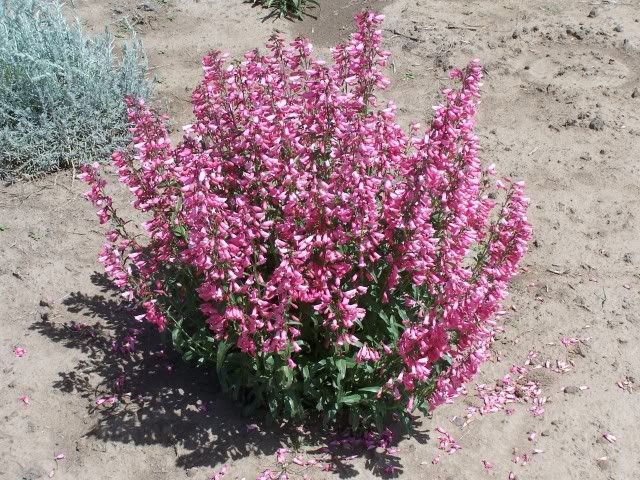
Re: Anyone have an interest in O. polyacatha?
Aaron
Nice Pent. You can take stem cuttings off Pents. If you want to know how, check out the American Penstemon Societies web sight.
http://apsdev.org/propagation/index.html
Re: Anyone have an interest in O. polyacatha?
Bob
Aaron and I are friends with LaMar Orton the owner of Plantasia Cactus Gardens, located in Twin Falls Idaho. Here is a link to pictures he has posted on his web sight of his display garden.
Very cool. Lots of maintenance, I see. (I tried to find someone to help me in the garden, but to no avail.)
I mostly like chollas and echinocereus, because the free space in my garden is shrinking rapidly. They do well in containers, though.
Bob
Re: Anyone have an interest in O. polyacatha?
Aaron
Nice Pent. You can take stem cuttings off Pents. If you want to know how, check out the American Penstemon Societies web sight.
http://apsdev.org/propagation/index.html
Thank you! I put that website to my favorites. 8)
Re: Anyone have an interest in O. polyacatha?
More exiting plants, Aaron and John! I am starting to think I ought to build a glasshouse to be ready to my coming collection of hardy Opuntias! ..that is when I get some spare time.....
I have tried hardy Opuntias (can't recall the names though) three times but they never shrivel even in late fall and end up as a mess in a year or two. Too wet autumns and winters.
Re: Anyone have an interest in O. polyacatha?
Always a bad sign. I find it interesting that plants from cold climates, where the onset of cold weather is later than here, often enter dormancy later, and can be damaged or killed by cold, even though at their peak of dormancy they would endure the same cold temperatures.
And that you can see this process in the garden. The native Cylindropuntia imbricata has already lost its moisture and is ready for anything, but plants from lower latitudes, like C. spinosior (which seems to be getting quite tired of me and my garden) are not.
Bob
Re: Anyone have an interest in O. polyacatha?
I find it interesting that plants from cold climates, where the onset of cold weather is later than here, often enter dormancy later, and can be damaged or killed by cold, even though at their peak of dormancy they would endure the same cold temperatures.
And that you can see this process in the garden. The native Cylindropuntia imbricata has already lost its moisture and is ready for anything, but plants from lower latitudes, like C. spinosior (which seems to be getting quite tired of me and my garden) are not.
It must be due to a physiological reaction to the length of day more than to the onset of cold weather.
Don't they use the term "photoperiodism" to discribe this type of reaction to changing length of day? Or is there a better term to use?
Re: Anyone have an interest in O. polyacatha?
It must be due to a physiological reaction to the length of day more than to the onset of cold weather.
Predictive dormancy is used by plants (generally) adapted to the local climate to enter the dormant period, and this is usually based on day length. Technically, it's based on night length, but nobody ever goes around saying "night length".
Consequential dormancy is another strategy, when a plant is triggered into dormancy by a cold snap, or by cold experienced prior to the time it would ordinarily undergo predictive dormancy.
So you can have two plants of the same species that are equally cold hardy, but the one from North Dakota will go dormant before the one from southern New Mexico.
In fact you can see this happen. Both the catalpa down the street and the desert willow in my front yard start losing their leaves at the same time, but the chitalpa next door gets its leaves frozen. So do desert willows from places like Arizona. (There are about 8 of them here, from all over the southwest.)
My desert willow is from a famous plant south of Santa Fe, has endured everything Denver's weather can throw at it for over 20 years, but the chitalpa's desert willow half is apparently from a more southerly accession and doesn't go into dormancy as early. (Tashkent, where the chitalpa was bred, is not particularly cold, so they would have had no reason to look for a specially cold-hardy form of desert willow.)
Bob
Re: Anyone have an interest in O. polyacatha?
Predictive dormancy is used by plants (generally) adapted to the local climate to enter the dormant period, and this is usually based on day length. Technically, it's based on night length, but nobody ever goes around saying "night length".
Consequential dormancy is another strategy, when a plant is triggered into dormancy by a cold snap, or by cold experienced prior to the time it would ordinarily undergo predictive dormancy.
So you can have two plants of the same species that are equally cold hardy, but the one from North Dakota will go dormant before the one from southern New Mexico.
In fact you can see this happen. Both the catalpa down the street and the desert willow in my front yard start losing their leaves at the same time, but the chitalpa next door gets its leaves frozen. So do desert willows from places like Arizona. (There are about 8 of them here, from all over the southwest.)
My desert willow is from a famous plant south of Santa Fe, has endured everything Denver's weather can throw at it for over 20 years, but the chitalpa's desert willow half is apparently from a more southerly accession and doesn't go into dormancy as early. (Tashkent, where the chitalpa was bred, is not particularly cold, so they would have had no reason to look for a specially cold-hardy form of desert willow.)Bob
I have seen this happen in my garden with Opuntias collected in North Dakota as compared to those collected in Arizona. It doesn't matter to the North Dakota plants, if it is 80f and damp or 40f and dry, every year they will go dormant and shrivel right on cue.
Re: Anyone have an interest in O. polyacatha?
I have seen this happen in my garden with Opuntias collected in North Dakota as compared to those collected in Arizona. It doesn't matter to the North Dakota plants, if it is 80f and damp or 40f and dry, every year they will go dormant and shrivel right on cue.
Yep. And for some cactus, the gymnocalcyium with the tissue damage for example, if it had had time to lose enough moisture before getting its rear end (literally, that was the back side of the cactus) frozen, it might have made it through much colder temperatures later on.
This happened with an enormous Agave havardiana x scabra cross that I had planted in the front garden to startle visitors during the 2002 NARGS tours. A 70 degree drop in temperature in November turned the thing to complete mush within a day.
(Scabra isn't really hardy here but I thought I'd give it another try.)
Bob
Re: Anyone have an interest in O. polyacatha?
Bob
I meant to comment on your last photo. Did you drug that poor droopy Imbricata? It is extremely limp!! ;)
We all know how O. polyacantha can hybridize with other Opuntias here are a few examples I grow.
'Claude Arno' O. polyacantha x O. fragilis
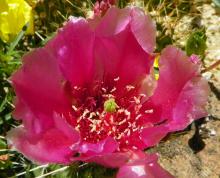
Possible hybrid O. macrorhiza x O. polyacantha
Devils Tower, Wyoming O. polyacantha x O. fragilis
Re: Anyone have an interest in O. polyacatha?
I finally got 'Claude Arno' last summer, at the DBG plant sale, after looking for it for years. 'Claude Arno' was the reason why Mary Ann called me all those years ago, she was looking for it too, having been friends with Barr .....
The trouble with opuntias, and it is big trouble, is the Cactus-Sucking Bug. I'm sure it has real name, but they attack pads and puncture them and then you have all these light green circles all over your cactus pads.
Dr. Bronner's takes care of them, but I decided it wasn't worth the trouble.
At least we don't have the giant cactus beetle here.
Bob
Re: Anyone have an interest in O. polyacatha?
Chelinidea vittiger aequoris is the one a friend was plagued with a few years ago. He said he had not noticed them until he saw the nymphs scury for cover one day on a stroll through his garden. It didn't take long to get rid of them but he had to treat the whole garden to do it.
Here are some links to information on the "little offenders". They even have mugshots. >:(
http://www.gatescss.org/Pests/Opuntia%20Bug%20Cactus%20Bug%20Opuntia%20B...
http://colinlmiller.com/wildlife/hemiptera/hemiptera_pricklypear.htm
Re: Anyone have an interest in O. polyacatha?
Of all the cylindropuntias, C. imbricata is the hardiest, but in your climate it would be very marginal. I wish you luck in finding a clone that will grow in your area. The good thing is, it only takes a small branch cutting to get a start going.
I've heard that C. davisii is one of the cold hardiest of all the chollas. I know of one in a Massachusetts garden that grows well without a mark on it, so it can handle some moisture too. C. whipplei is very hardy too though the hardier forms tend to stay lower and spread.
Re: Anyone have an interest in O. polyacatha?
Named Hybrids and selections abound. Here is a small parade of a few that have flowered for me.
Opuntia polyacantha Claude Barr hybrid I do not know the original name of this one. It has been passed from gardener to gardener to gardener etc.... for years and came to me unnamed. It looks like a possible hybrid with O. aurea. If anyone knows the name I'd like to know.
[attachthumb=1]
You gave me two pads of this one John and I would say it is very likely a polyacantha x aurea hybrid or possibly even polyacantha x pinkavae. Its doing ok here so far.
Re: Anyone have an interest in O. polyacatha?
Welcome to the forum, Andy!
I am always keeping an eye out for the hardiest cholla, and one that might stand heavy snowfall better. You just never know...
Re: Anyone have an interest in O. polyacatha?
Thanks Rick!
Here's a pic of that C. davisii growing in Northhampton, Mass. It may have been flattened a bit from the October snowstorm.
Re: Anyone have an interest in O. polyacatha?
Here's a pic of that C. davisii growing in Northhampton, Mass. It may have been flattened a bit from the October snowstorm.
Welcome Andy, glad you finally made it to the forum!
That's a cuddly cacti isn't it ;) The fact that it is growing in Northampton gives encouragement that more cacti will be hardy here in Massachusetts; I just so happened to be in Amherst and Northampton yesterday, a fine mild sunny winter day, although I have to admit, nary a thought about cacti all day ;). The surprise pre-Halloween October snowstorm played havoc with trees that were still in full leaf, many trees were devastated (as were power lines), I suspect this cactus will have managed just fine. I hope that you'll be showing us some of the hardy cacti growing in your Connecticut garden, which will give us fellow New Englanders clues about which ones to try here. By the way, is that plant growing in a private garden?
Re: Anyone have an interest in O. polyacatha?
Hi Mark, That plant is in the hardy cactus garden at Smith College. Most of the plants there do amazing and flower well. Its built right up against a brick wall of the greenhouse facing South baking in the sun all day. I didn't say anything to them but close to half the cactus there are improperly named. I love their garden though and have many pictures, would make a good thread of its own.
I surely will be posting pictures of my plants though they don't like much right now ;D
Re: Anyone have an interest in O. polyacatha?
Here's one of my favorite O. polyacantha varieties. It's var. schweriniana, likely not an 'official' variety but it fits for me. Basically miniature clones of polyacantha that grow in higher elevations. For those with small garden these work out well.
Re: Anyone have an interest in O. polyacatha?
Now with that small one, I might actually be persuaded to grow an opuntia in the garden. Does it bloom as well as the normal sized species? What color?
Re: Anyone have an interest in O. polyacatha?
This one hasn't flowered yet, fingers crossed for this year. I do not really know but can't see why they shouldn't bloom as well as any full sized polyacantha just that the blooms will be small like the pads. Any polyacantha flower color is possible and I'm in for a surprise if/when my does.
Re: Anyone have an interest in O. polyacatha?
This strange thing is occurring with one of my polyacantha x fragilis plants. What clearly looked to be a new pad is now all the sudden getting a flower bud crown on top! The smaller flower bud on the right is normal in size, the bud/pad is kinda wacky. What will it do?
[attachment=1]
Re: Anyone have an interest in O. polyacatha?
I've seen things like that before. They can get wierd, I have seen flowers after they bloom go into odd shaped pads.
Very cool, thanks for sharing. :)
Re: Anyone have an interest in O. polyacatha?
Hi guys
It is always interesting to see what opuntias will do next.
Last year one of my O Basilaris had a flower bud produce three flowers at once. All I can think is that it was damaged in some minor way when it first developed.
Re: Anyone have an interest in O. polyacatha?
John, it was worth the wait! Emmons County polyacantha in Connecticut
[attachment=1]
What a beauty, slightly frilled double layer of petals with creamy white edges transitioning to a slightly deepened yellow all topped off with nice bunch of ruby red filaments!!
Re: Anyone have an interest in O. polyacatha?
Glad to hear your delighted. I've always liked that particular clone. I have grown it for many years and hope it is as reliable for you as it has been for me.
By the way that is the best photo of it I have ever seen! Simply Stunning!! Excellent Work Andy!!!
Re: Anyone have an interest in O. polyacatha?
By the way that is the best photo of it I have ever seen! Simply Stunning!! Excellent Work Andy!!!
Thanks for the compliment but I can do better ;D The lighting was nearly ideal as it was cloudy (a little too cloudy) but the backround is much too white which takes away from the flower. A few more buds to go so I'll keep trying.
Re: Anyone have an interest in O. polyacatha?
John,I think I have a O. macrocentra O. polyacatha cross. I thought it was a O. macrocentra, but now I now it to be a cross, has nice pink/rose flowers. I will try and post some pics soon. :)
Re: Anyone have an interest in O. polyacatha?
Can't wait to see it!
Re: Anyone have an interest in O. polyacatha?
The dark long spines do show signs that macrocentra was involved and the even covering of spines across the pads shows the Polyacantha connection. These illegitimate offspring of inter-species cross pollination are not bad looking plants. Do you see more purple hues on the pads in cool weather?
It will be interesting to see which parent influences the flowers.
Re: Anyone have an interest in O. polyacatha?
The dark long spines do show signs that macrocentra was involved and the even covering of spines across the pads shows the Polyacantha connection. These illegitimate offspring of inter-species cross pollination are not bad looking plants. Do you see more purple hues on the pads in cool weather?
It will be interesting to see which parent influences the flowers.
Looks like most of their trates are from the pollen donner connection, I have read this is true for most cross?
I see more purple but not much.
I will try and find pics of the plants before they died.
Re: Anyone have an interest in O. polyacatha?
Here is some pics of the two in flower.
http://unkowndestination.blogspot.com/2012/06/hybrid-pricklypear-and-other-flowers.html
Re: Anyone have an interest in O. polyacatha?
I guess i forgot to post a follow up picture of that weird bud/pad I posted about one year ago. Well here it is
[attachment=1]
After the flower wilted it stayed around as a regular pad.
Re: Anyone have an interest in O. polyacatha?
Very cool. :)

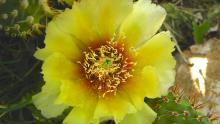
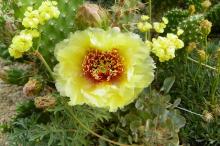
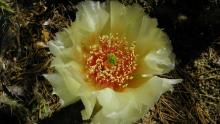
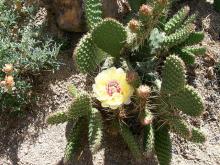
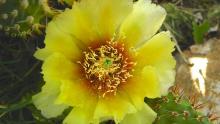
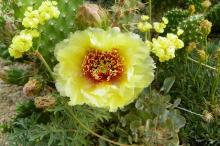
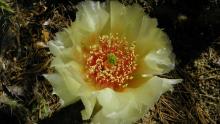
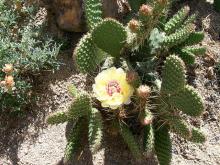
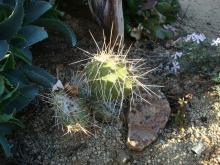
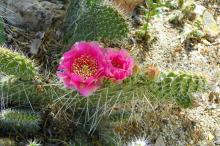
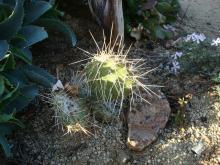
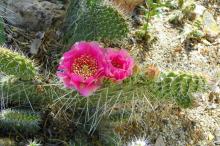
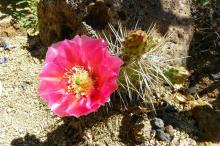
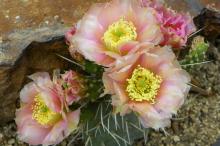
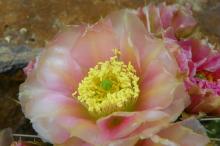
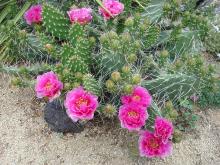
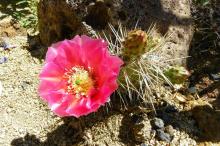
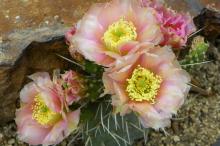
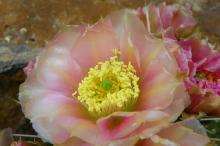
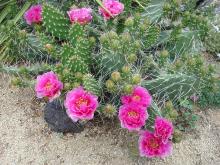
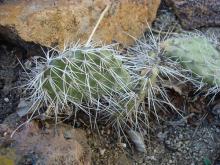
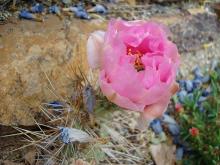


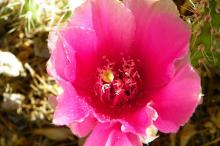
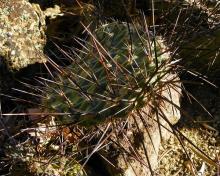
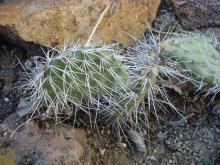
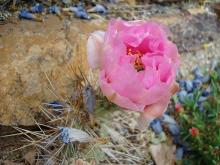
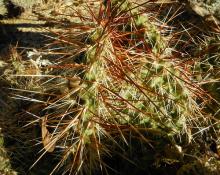

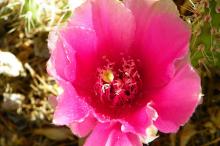
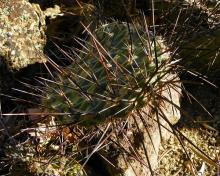
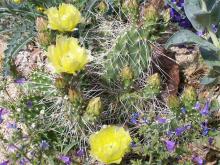
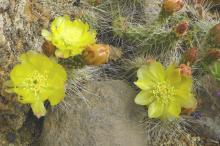
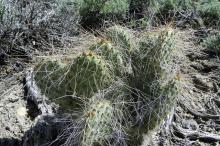
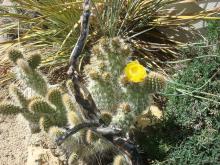
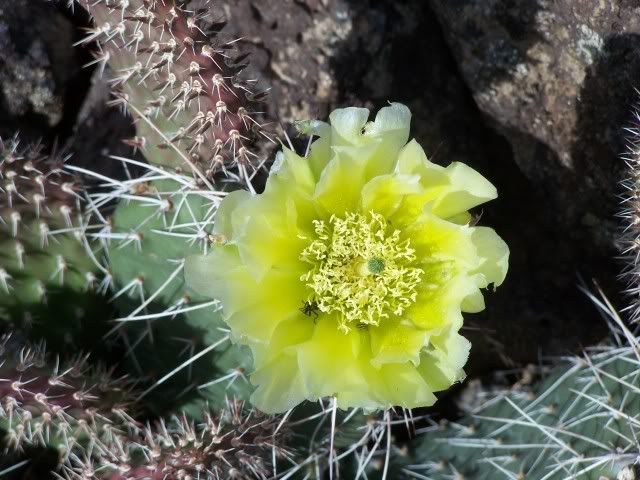
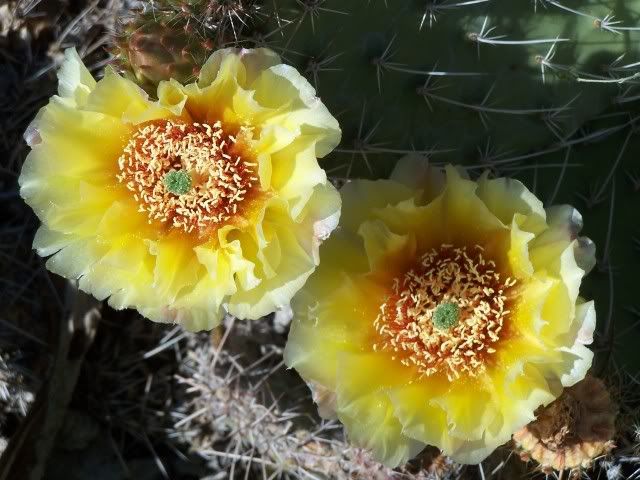
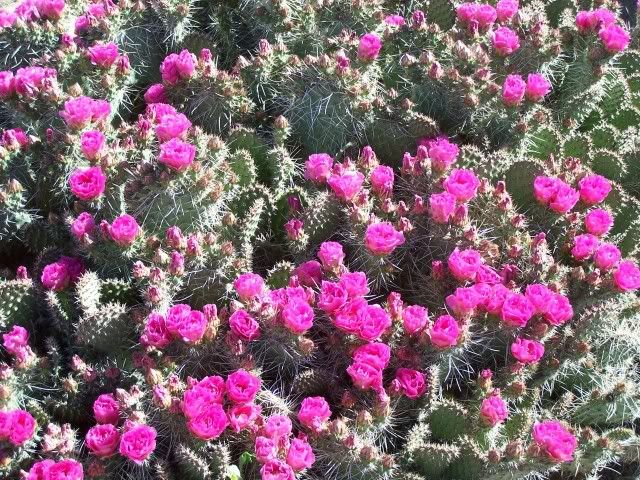



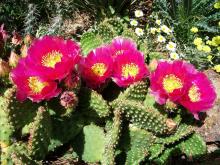
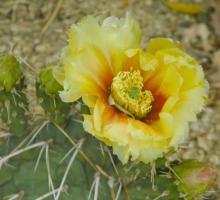
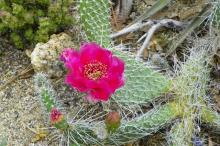
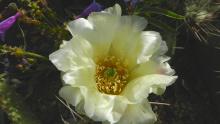
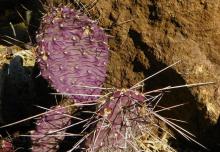

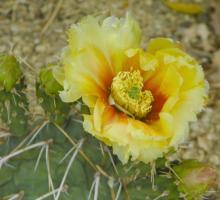
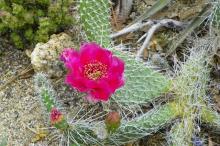
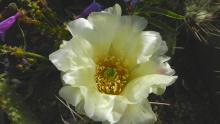
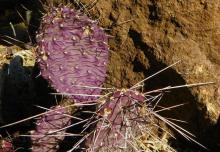
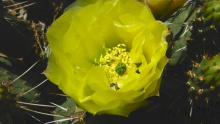
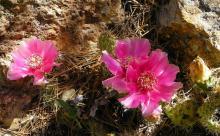
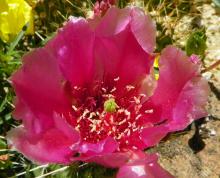
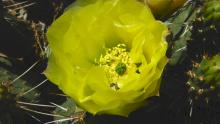
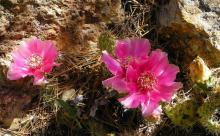
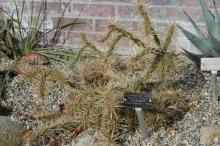
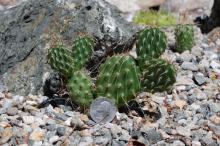
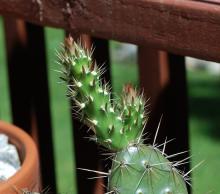
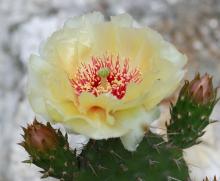


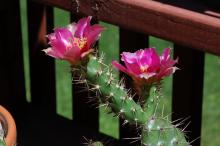
Although I like to see Opuntias and photos in other people's gardens, I don't grow any myself. I like cactus, but prefer to shy away from those with "inescapable" glochids. The exception would be if I could find a tree form (ex: O. imbricata) cold hardy enough for me.